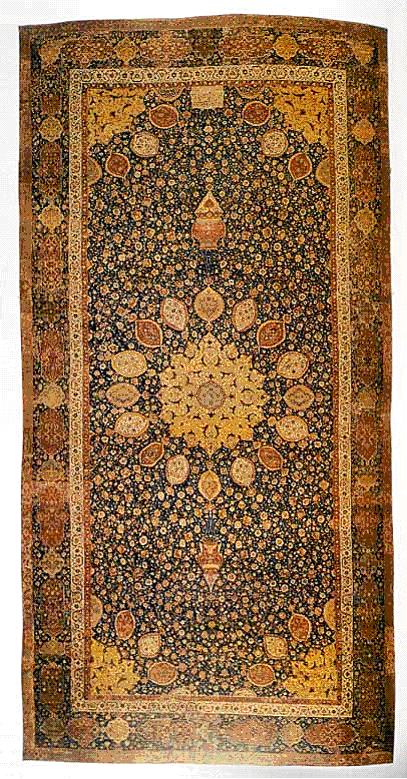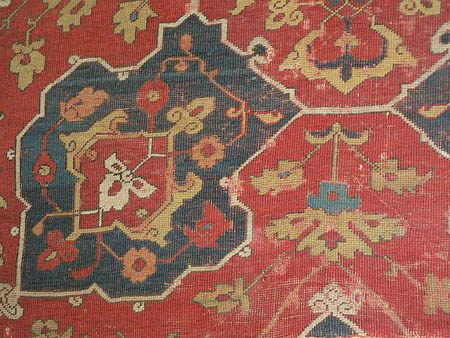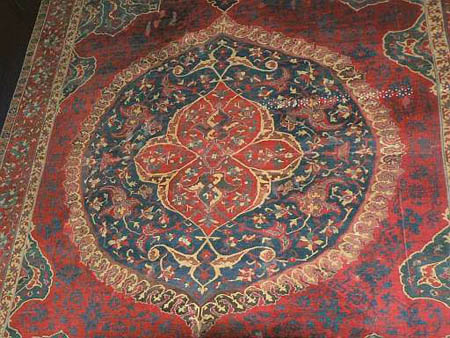by Chuck Wagner

Having previously read through the Traveler’s Reports on the Victoria and Albert Museum (the V&A) by Richard Farber, Rich Larkin, and John Howe, I jumped at an opportunity to visit the museum last November, and was very impressed with the Islamic Gallery exhibit.
A bright and sunny day made the viewing during the first visit reasonably good, although some darker pieces were difficult to see clearly (by clearly, I mean lighted sufficiently to really be able to appreciate the dyes on pieces known to be from the 16th century). However, during that trip I was sans camera. Oops…
I was back in the UK again in January (five minutes of advance planning ensured that this time I had the digital camera came with me), and the weather was far more typical of Merrye Olde England in winter: overcast, cold, windy, and rainy. Excellent pub-crawling and museum weather, actually, but not particularly conducive to Great Photography. Thus this long lead-in to: These are all flash photos, and I was compelled to modify the images to cause the color and intensities to better reflect what I remembered of the pieces on display.
Appreciating the impact of bright light on dyes, I was pleasantly surprised that the V&A allowed flash photography, and snapped away until the memory card was full.
Before we get to my dodgy pictures, here are two images from the V&A website showing the new Islamic Gallery at its finest. I would have paid money to have lighting like this on the last trip (it wasn’t this good with full sunlight !). The first image is from the left rear of the gallery, looking over the Ardebil carpet toward the gallery entry. A case containing Central Asian chyrpys is partly visible behind the column at the far right of the image:

In the next image, showing the rear left corner of the gallery, we see the Chelsea carpet on wall at right, and an unnamed Isfahan carpet to its left (pictured below), with several smaller pieces beneath. Pay attention to the little piece at the lower right; I will be whining about the lighting of this area later on…

An additional note: I did not buy the museum catalog, and did not spend a lot of time documenting the narrative details on the display cards. So, the information on these pieces is highly variable; I have found occasional detail in print and on the web. Several of the pieces have been written about extensively; some links to online articles are included below. My purpose here is to present you with decent close-ups of some very old pieces, and to try to represent the unarguably non-synthetic dyes as faithfully as possible. A few images from the V&A online image facilities are included so we can all appreciate some of the pieces in their entirety. The V&A online images were found after the last visit, so I feel better about my image fiddling now – the colors look about right.
We’ll start in the center of the gallery with the most obvious and famous choice, the Ardebil carpet. It is now displayed flat on the floor (having previously been hung on a wall) behind non-reflective glass that one can easily walk into without noticing its presence in advance. This carpet has a lot of literature on record; here is a link to a recent article on the V&A website: http://www.vam.ac.uk/res_cons/conservation/journal/number_49/ardabil_carpet/index.html
Some technical details about the carpet:
Dated 1539-1540
304 kpsi silk on silk, wool 10 colors
Warp: cream or undyed silk. 35 threads per square inch
Weft: cream or undyed silk. 3 paired shoots after each row of knots
Knot: asymetrical; 340 per sq. inch
Pile: wool, 3 shades of blue, 3 shades of red, yellow, green, black and white V&A website

The size of the carpet (34 ft, 6 in x 17 ft, 6 in) can be appreciated in this image:

There is a highly variable and very pleasant abrash in the carpet, and the level of detail in the design is impressive:



Next on the tour, at the front of the gallery (and hiding behind a display wall), is an all wool Mamluk carpet from Egypt dated 1468 – 1496 and annotated as S5Z (no explanation, but presumably referring to the yarn). Reminiscent of some of John’s flea market finds, this piece is in rough condition. Still, given the wear, the pattern is still obvious and the colors subtle but pleasant. I find the rams-horn design in the minor guard border interesting:

Note the pale green and what appears to be a teal blue (faded yellow, formerly green ?):

Along the right wall, we find some Anatolian items; including a couple of fragmentary Uşak carpets; the first is dated 1450-1550, the second dated about 1500…


…and a complete Uşak medallion carpet, dated 1500


